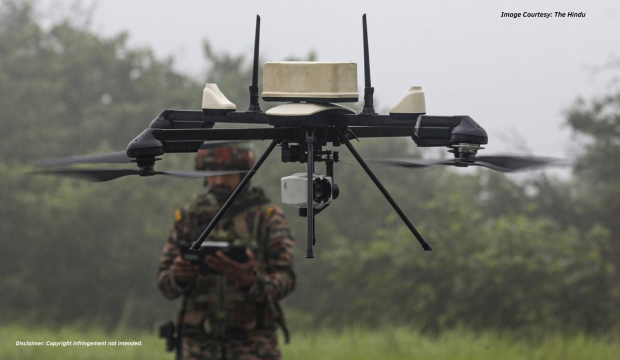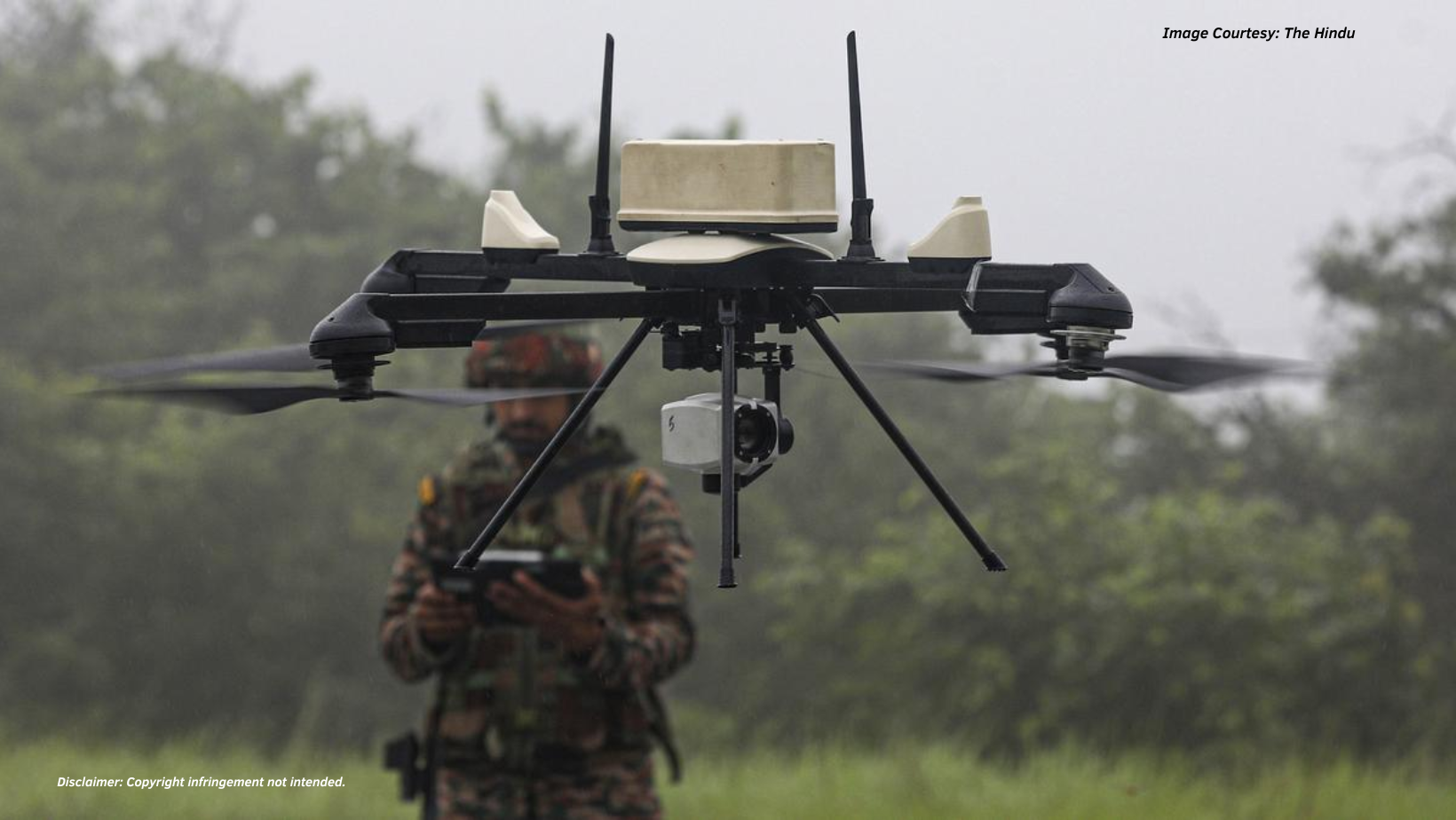Abstract
Gray zone is usually described as a space between peace and war where the belligerent employs tactics without making them reach the threshold of conventional warfare; they are irregular, hybrid tactics, or proxy wars, which make it difficult for the rival to counter these threats effectively. There is no winning in gray zone warfare; one can only achieve escalation dominance over the other. Gray zone warfare can be exercised at seven levels; cyber, space, people, air, land, economy, and water, through various means. In conventional warfare, there is a confrontation over a specific region, whereas in gray zone warfare, there is growing contestation over space between nations, and unlike conventional warfare, where the contested space is defined, gray zone warfare sees contestation and confusion over space.
This article analyses the gray zone capabilities of Pakistan, which technologies strengthen its ability to operate in gray space, and how it is employing them against the interests of India. This article will focus only on the military aspects of the gray zone.
Introduction
Pakistan, the immediate neighbour of India with whom four wars have already been fought since Independence, continues to launch threats in the gray space against India. Pakistan is actively acquiring advanced technologies and is finding new ways to escalate the crises to continue the belligerence while making sure that it doesn’t become a conventional warfare, as it is not in the interest of Pakistan. Despite being an economically weak nation, their defence budgets aren’t going down, the political drama made only some scratches on their military power without degrading them considerably. They are weak enough to wage a direct war with India as most of their defence resources are eaten up by the TTP and Baloch problems, but Pakistan is strong enough to keep a check on its neighbouring power, India, through non-conventional methods.
As the attacks make sure not to cross the red lines, retaliatory measures taken by the rival state tend not to cross the threshold level in order to maintain the notion of proportionality.
Non-traditional activities like diplomatic and cartographic aggression, information warfare, election rigging, cognitive warfare, proxy war by Jihadis, cyber-attacks, compromising historical truths, fake discourses and narratives, and political-economic interference use military and non-military ways to create trouble for India. Economic muscle provides the foundation of a strong nation; an economically well-off nation can support and maintain large military infrastructures. The cognitive domain plays an important role in determining how much faith citizens have in their system.
What Is Gray Zone Warfare?
Gray zone is an ill-defined space between war and peace: war refers to a full-scale war whereas peace is associated with complete absence of bitterness. It is difficult for adversaries to remain at complete peace but exercising an all-out war is also impossible. States cannot practice either of the two extremes, their motive of causing harm and degrading their rival state capabilities remain intact, to further their aim, states rely on utilizing the gray space through gray methods. Gray zone uses military and non-military tools to fulfill its aims.
Gray zone attack is a continuous, multi-level game where adversaries are threatened by non-conventional measures, it is generally non-violent in nature and is practiced for a prolonged time. Gray zone is ambiguous in nature to achieve dominance over others. Not crossing the red lines, remaining under the threshold is the salient feature of gray zone warfare that differentiates itself from traditional warfare practices. It is a strategic competition where the threshold should not be crossed, which can trigger a greater response, escalation ladder is usually increased as states continue to acquire more advanced technologies. The state with the most advanced technologies or resources cannot be guaranteed dominance in gray conflict as implementation of gray tactics is a matter of art, a state’s supremacy in escalation at one stage of a conflict does not prevent its adversaries from escalating the conflict to lower stages; in fact, it could even encourage them to fight at a lower level . The escalation ladder can be increased or decreased.
An essential feature of the gray zone is the inclusion and use of civilian and non-state actors, according to Boucher, democratic states face challenges in using gray capabilities due to state apparatus and decentralized structures, non-democratic adversaries like Pakistan and China which have centralized command over power, can use propaganda, legal structures and economic coercion more easily than a democratic state like India. Domestic environment and dynamics dictate international influence as well.
Retaliatory measures and responses depend upon the impact of gray warfare. A terror attack driven by State sponsored proxy war in Kashmir, which kills local civilians draws a measured response. India responds to it by compensating the family, while neutralizing terrorists involved in the attack, exposing the proxy support and generating consensus among the international community. The impact of Pulwama attack was huge, since it challenged the security apparatus of India. India retaliated in a calibrated manner with Balakot air strikes. Response measures are different when non-human resources come under threat, eg attributable cyber attacks may be responded to by counter cyber threat, the intensity and timing may be varied, but cyber-attacks will be responded to by cyber-attack. The response may also include economic and diplomatic measures.
Air Surveillance Capabilities
Intelligence, Surveillance and Reconnaissance (ISR) capabilities serve as a major asset, information and data from India have come under threat and continue to be vulnerable against Pakistan’s actions. Aerial platforms like UAVs, drones, swarms, hang gliders and powered gliders are major tools to develop situational awareness of aerospace. Apart from gathering vital information they also assist in threatening ISR capabilities of rivals. An efficient gray zone capability requires flexible mobility and precision weapons to deliver accurate information. Pakistan’s surveillance over the LoC, PoK, and international border strengthens their knowledge about India, provides deep eyes into our territories, and leaks out vital info regarding infrastructure, military installations and geography.
PAF has gained substantial support from the US, its F-16 fleet carries electro-optical and infrared (EO/IR) sensors, which could capture live video and monitor an area at nighttime and can identify enemy radars . PAF has around 10 AEW&C (airborne early warning and control) aircraft, allowing it to effectively provide around-the-clock surveillance across India. ZDKs and ERIEYE can search deep inside India. Aerial deterrence is exercised in two ways: by denial and by coercion against India. In order to avoid jamming of its systems and infrastructure, the Pakistan Air Force possesses a Falcon DA-20 Electronic Warfare aircraft. In contrast, IAF aircraft rely on jammers, which are often bulky and restrict range and weapon capacity. The Rafale has EW capacities.
UAVs/ DRONES
The use of UAVs or drones for infiltration operations lowers the risk to human operatives by allowing them to be remotely controlled and flown from a safe distance, minimising the cost of loss too. They fly at high altitude at low speed, making their detection by border forces difficult. Efforts on minimising the size of the UAVs are ongoing, making them even more difficult to detect. Drones are a useful tool for transporting commodities over borders, including firearms, explosives, drugs, and other materials, since they can deliver payloads across great distances. Fourth, drones could potentially be used for espionage, giving unauthorised persons the chance to obtain private information about military locations, vital infrastructure, and other important targets. In June 2021, two improvised explosive devices were dropped by terrorists via UAV in the technical area of Jammu Air Force Station. Pakistan’s intelligence agency Inter-Services Intelligence (ISI), and the Pakistani Rangers have established six drone centres opposite India. States like Rajasthan, Gujrat, Haryana, along with UT Jammu and Kashmir, are more prone to UAV attacks and intrusions.
Year | 2020 | 2021 | 2022 |
Jammu | 20 | 30 | 25 |
Punjab | 48 | 65 | 267 |
Rajasthan | 10 | 8 | 23 |
Gujarat | 2 | 2 | 8 |
Total | 80 | 105 | 323 |
Naval Strength- Sensors, AIP, Midgets
Naval capabilities of Pakistan rely on Anti-access and anti-denial (A2/AD) posture in the Indian Ocean . A2AD is an operative strategy to deny access to their operative space and deny the freedom of action in that space to the contender. Cyber and space domains are critical in this sphere. Pakistan operates four frigates of type 054 from China, which are equipped with advanced sensors and modern armaments, most of them are capable of anti-surface and anti-submarine warfare, tilting tactical advantage towards Pakistan. These conventional weapons are fitted with non-conventional offensive and defensive capabilities that target enemy radars, weapons providing necessary information to the Pakistan Navy. Pakistan’s Navy invests heavily in building their naval capabilities as major ISL (International Shipping Lanes) pass through Pakistani waters, extending their influence towards the Indian Ocean and the greater Arabian sea serves them and China. China is assisting the development of Gwadar port. The Tughril class of 054 can executemultiple missions, Zulfiqar and Taimur class can neutralize sea, coastal, and aerial targets, including low-flying anti-ship missiles. Zulfiquar’s technology has flaws since its lock-on-target technique has been shown to be ineffective and poorly maintained.
PNS Hamza is equipped with an AIP (Air Independent Propulsion) system, and is the first conventional submarine in South Asia to have an AIP . Two of the Agosta-90B are acquiring this same technology, which boosts the underwater endurance and stealth of conventional submarines, which would normally need to surface to recharge with oxygen, making detection difficult. Their old cosmo-class submarine is prepared for mine laying. Reports reveal that China and Turkey are assisting Pakistan in building their midget submarine. Indian Marine Commandos (MARCOS) also own 500-ton midget submarines designed by Larsen & Toubro and built by HSL. They are low in cost, operate in shallow seas and are tiny, they blend in well with fishing boats and other coastal commerce craft, making them difficult to detect. The Pakistan Navy has developed a provocative, flexible mobility strategy that uses the sea space to control attrition from several multi-dimensional causes that weaken opposing troops. The electromagnetic and cyber domains are also included in the naval strategy’s domain and are neutralised by a variety of hardware resources and human capital that have a technical advantage over the enemy. Cruisers, destroyers, frigates, submarines, amphibious assault ships, and other fleet auxiliary vessels keep them in the game. The massive investment and aid coming from China to Pakistan to counter India’s supremacy in IOR is not without constraints. However, on several occasions, Pakistan has raised complaints over poor quality of material and systems that produce faulty images and data. In 2019, the Pakistan Navy criticised Chinese-made Z-9CE helicopters, an AWS variant purchased in 2006.
Radars
TPS-77 radar provided by Lockheed Martin is deployed in Chor Cantt, only 58 kilometres away from the international border (IB), and has a range of 463 km for long-range missions and 150 km for low-level flight surveillance missions. China has given the SLC-18 radar system, which is an active electronically scanned array (AESA) that can scan drones, missiles, and aircraft in LEO (Low Earth Orbit). SLC-2 weapon locating radar was upgraded with SLC-2E, delivered by China, which has a range of 80-90 km, and is a multi-targeting system. Radar systems can detect artillery, trajectory of missiles and transfer coordinates to Pakistan. Pakistan was the first among the two nations to get a weapon-locating radar, the AN/TPQ-36 Firefinder, a mobile radar system against India.
Balloons
Pakistan uses the Tethered Aerostat Radar System, developed by the US Air Force, a balloon surveillance system that can go up to 15,000 feet, and is supported by a radar system. Pakistan has aerostat balloons but they are not active currently. The IAF deployed two aerostat balloons on the western border.
Cyber
Some suggest that Pakistan has been the first to exploit cyber space, in May 1998, Pakistani hackers hacked the Indian Bhabha Atomic Research Center’s website, and again in 1999, they defaced the Indian Army website. First visible work of Pakistan Cyber Army (PCA) was seen in 2008 when they defaced the Indian Oil and Natural Gas Company, around the time of the Mumbai attack. ‘Advanced Persistent Threats’ (APTs) or PCA gathers vital information about their rival nations and are responsible for undertaking cyber-attacks. Cybersecurity firm Proofpoint in its report on Operation Transparent Tribe revealed attacks by APT. They have conducted spear phishing campaigns in Saudi Arabia and Kazakhstan in February 2016 against Indian embassies. Black Lotus Labs, a US cybersecurity firm, disclosed that Reverse Rat 2.0 , a Pakistani malware compromised an Indian government website. In February 2016, the Indian Army issued a warning regarding SmeshApp, a chat programme that is widely used by Indian Army troops, as per the Army, ISI gathered information through army phones. Cyber assets are prone to attacks as they rely on algorithms and mechanisms that can be exploited, hacked, and leaked.
In terms of cyber security, India-Pakistan are almost at an equivalent level. A covert bilateral meeting between Turkey and Pakistan helped the latter in setting up a cyber army , as both perceive the Kashmir issue with hostility.
Space
With technological advancements, space expeditions have become an important sector in which every nation can exert its power. With this space race, space militarization i.e., aiding military operations on land, air, and sea through space technologies is increasing, China and India successfully tested ASAT (anti-satellite system) in 2007 and 2019 respectively. Pakistan does not have the ASAT technology, but China’s friendship can cater to their needs. China is assisting Pakistan in building its navigational system.
Space is a gray area to weaken the enemy, and satellites are deployed for dual uses- civilian and military. Disruption or hacking of India’s satellites can severely harm our communication system and along with that it can compromise our data as well. Satellites also provide a birds-eye view of secret installations.
Information Warfare
In February 2019, social media handles propagated false messages regarding the Balakot strike, tags like #PakistanZindabad, #SurpriseDay, and #TeaIsFantastic floated all over twitter, various memes, images, videos insulted India when an Indian Pilot landed in Pakistan. During the Balakot counter-strike, Pakistan claimed that no F-16 had gone missing, refuting India’s claim of destroying a Pakistan F-16. Inter-State Public Relations (ISPR), the media wing of the Pakistani military, manages social media propaganda. On 14 January 2022, a Pakistani based think tank, Legal Forum Kashmir along with Stoke White, a UK-based firm, abused the Indian government of Human Rights violations in Kashmir. Dawn investigations in 2017 publicized that 41 of Pakistan’s 64 banned outfits are active on Facebook undertaking a fake information campaign further.
Information Warfare (IW) consists of Influence warfare (IO) and psychological warfare (PW) – the former exerts the type of influence they want to have over rival populations, while the latter entails energising emotions and actions in rival populations, both disrupting and moulding the facts in order to create a false narrative to change the observation of rival people. It mends the behaviour and actions of the target audience in a way that serves the interest of the propagator.
Militancy In Jammu And Kashmir
After Pakistan’s defeat in direct confrontation with India, they started financing around 100 madrassas in Kashmir to provide military training to disaffected youth and by inviting various mujahedeen fromAfghanistan. The USSR’s withdrawal from Afghanistan left Pakistan with ample arms and ammunition that were infiltrated in J&K. Religious teachings, biased education, dissemination of false information are ways to ignite violent protest, social conflict, terror movements. On January 1 2023, four civilians were killed by militants in Rajouri District. On August 6, 2023,a terrorist was killed when Security Forces (SFs) thwarted an attempt to infiltrate the Kupwara District.
Terror activities in Kashmir are endless, and the basic reason behind this type of proxy war by Pakistan against India is to bring the latter to a level of strategic fatigue, by employing attacks and threats that do not cross the threshold but continue to pose serious security concerns for India. Through this, they can keep a check on the conventional capabilities of India as well. To degrade India’s superiority in conventional combat and to maintain horizontal and vertical escalation. The proxy war in Jammu and Kashmir is led by religious differentiation, and it leverages the past hostility between the two religions. Pakistan crafts its terrorism policy carefully, making sure that it doesn’t cross India’s tolerance limit . The main aim is to destabilise India, its economy and political structure to hinder state governance which will divert sufficient energy, resources and time. keeping India away from its development agenda.
Kargil War- Gray Zone Conflict
Kargil war is considered to be classified between gray zone conflict and full-scale war. It was the result of the hostility between India and Pakistan, Kargil highlighted Pakistan’s growing resentment against India after getting defeated in the 1971 war. The Indian Army in their Operation Meghdoot, 1984, successfully captured the Siachen territory, and the speedy recovery of our land came as a shock to Pakistan. Actions like these are subtle and swift ways which create sudden and surprising results, making sure that the rival (on whom it has inflicted) will not cross the red line. Pakistan thought of practising a similar strategy in 1999, assuming that India would not be doing anything that will go beyond reciprocity- fortunately, India did. As both the powers were nuclear, it was imperative for both the powers to not cross the nuclear threshold, as it could lead to instability in South Asia. Pakistan, knowing that India’s no first use nuclear policy will not create a hurdle for Pakistan, thereby placing the responsibility of following the logic of military escalation avoidance on India.
India first employed drones in combat against Pakistan in the 1999 Kargil conflict, first UAVs were purchased from Israel. The conflict also highlighted the need to improve communication lines and to acquire advanced reconnaissance and surveillance assets.
Challenges Faced By India Due To Pakistan’s Gray Capabilities
Threats from the gray zone have wide-ranging and complex repercussions, the challenge to stability and the potential for miscalculation are major consequences. Pakistan’s gray zone capabilities present several challenges in front of India that need to be resolved.
- China is an all-time friend of Pakistan, whose conventional and non-conventional capabilities are superior to India’s, The collusive nexus and thick Sino-Pak relations pose a major threat to India.
- Pakistan is India’s immediate neighbour. Geographical proximity along with similar cultures and religions, makes it easier for Pakistan to understand and exploit India’s vulnerabilities.
- India is confronted with gray attacks every day. Therefore, India needs to maintain heightened alert constantly, which leads to a continuous drain of resources and energy. Unlike direct war, where the time and space of contestation are specific, gray warfare expands the time-space continuum of attack.
- In conventional warfare, results were decided in days, weeks, or years, and a decisive result is certain in direct conflict. Conversely, in the gray space it is impossible for one nation to achieve complete victory over another, only dominance can be maintained, which can be changed dynamically.
- There are no clear rules or measures for conducting gray warfare, which makes counter-measures difficult.
Recommendations
Since discouraging Pakistan and China from exploiting gray threats against India is a challenge, we need to come up with specific strategies when dealing with gray zone threats. Pakistan has a strong military, but is a weak state. The task of navigating these difficulties in the gray area is difficult and calls for a multifaceted approach. India needs to devise a long-term strategy to address gray threats.
- Militancy and cross-border infiltration have come down in 2023, by focusing on creating internal stability, which accelerates socio-economic prosperity, limiting the spread of terrorism.
- Having an integrated communication system will expand our information horizons, and acquiring more sophisticated technologies from our partners like Israel, US, Russia, and Europe can boost our strengths.
- Exploiting the fault lines of rival nations by conducting focused IW against Pakistan, which is already embroiled in political instability Sectarian and provincial fault lines within Pakistan can be exposed through social media.
- Retaliatory cyber attacks and increased surveillance over Pakistan’s territory will provide vital information that can be exploited when time demands. For a long time, India has used its resources to maintain a strategic deterrence posture, to defend ourselves from attacks. It’s time to start focusing on our offensive and grey capabilities. AI enabled technologies can strengthen our responses.
- If Pakistan embarks on the trajectory of a failed state, the spillover effects would be detrimental for India as well. An environment which will suit India best is for Pakistan to realise the futility of its grey and sub-conventional strategies, which can provoke India to impose costs on Pakistan.
Conclusion
Gray space can be exploited in many ways by a State, which can be difficult to counter. Technology is the backbone of gray zone warfare. Pakistan is employing various types of grey threats and attacks against India, emboldened by support from China, with its superior technology. The gray war on two fronts complicates matters for India.
We can achieve and maintain dominance in gray space by improving our technologies and social cohesion. Economic coercion, IW, dissemination of misinformation are also other ways to disrupt the harmony of a nation state. India should exploit Pakistan’s gray space with a reciprocal and calibrated strategy, expanding horizontal and vertical escalation, as Pakistan is already embroiled in civil protests and the threat from anti-State terrorists, at a time when its economy is in doldrums.
The question is, can gray zone conflict ever be won? Russia used gray space to destabilize Crimea. No war has been won completely by gray zone- it is useful in achieving dominance in certain contests. Results of gray conflict are dynamic and temporary, and the dominant party changes. Gray zone capabilities can surely assist in kinetic and non-kinetic warfare, but the sole dependence on gray capabilities will not deliver any fruitful results.
DISCLAIMER
The paper is author’s individual scholastic articulation and does not necessarily reflect the views of CENJOWS. The author certifies that the article is original in content, unpublished and it has not been submitted for publication/ web upload elsewhere and that the facts and figures quoted are duly referenced, as needed and are believed to be correct.
References
- Proxy war in Kashmir & Pakistan’s economy | IPCS. (n.d.). http://www.ipcs.org/comm_select.php?articleNo=352
- Desk, E. T. (2020, January 16). Pakistan Outperformed India In Information Warfare – Indian Cyber Security Chief. Latest Asian, Middle-East, EurAsian, Indian News. https://www.eurasiantimes.com/india-heaps-praises-on-pakistan-armys-media-wing-for-information-warfare-against-india/
- Pakistan Cyber Army (PCA) – Hacking Indian Websites, Promoting Pakistani Interests In Cyber Space And. . . (2014, April 10). MEMRI. https://www.memri.org/cjlab/pakistan-cyber-army-pca-hacking-indian-websites-promoting-pakistani-interests-in-cyber-space-and-nurturing-pakistani-hackers
- Mustafa, Ghulam. “(PDF) Cyber Warfare Between Pakistan and India: Implications for the Region.” ResearchGate, https://www.researchgate.net/publication/347409992_Cyber_Warfare_Between_Pakistan_and_India_Implications_for_the_Region. Accessed 8 August 2023.
- Military applications of artificial intelligence in Pakistan and the impact on strategic stability in South Asia from The Impact of Artificial Intelligence on Strategic Stability and Nuclear Risk: Volume III South Asian Perspectives on JSTOR. (n.d.). https://www.jstor.org/stable/resrep24515.13
- “6-Defence Studies Book Cover (October 2011)_V3.” IDSA, https://www.idsa.in/system/files/jds_5_4_asingh.pdf.
- DAWN.COM. (2021, May 28). Concern voiced over militarisation of space and artificial intelligence by India. DAWN.COM. https://www.dawn.com/news/1626120
- “CENTRE FOR LAND WARFARE STUDIES.” claws, https://www.claws.in/static/IB-198_Grey-Zone-Conflicts.pdf.
- Azad, T. M., Haider, M. W., & Sadiq, M. (2022). UNDERSTANDING GRAY ZONE WARFARE FROM MULTIPLE PERSPECTIVES. World Affairs, 186(1), 81–104. https://doi.org/10.1177/00438200221141101
- Desk, W. (2023b, March 23). India needs capabilities to tackle ‘grey zone’ warfare from China and Pakistan: Army Chief General Manoj Pande. Organiser. https://organiser.org/2023/03/23/166036/bharat/india-needs-capabilities-to-tackle-grey-zone-warfare-from-china-and-pakistan-army-chief-general-manoj-pande/
- Blarel, N. (n.d.). Planes, Drones, Missiles: How Kargil changed Indo–Israeli Relations. The Caravan. https://caravanmagazine.in/vantage/planes-drones-missiles-kargil-indo-israeli-relations
Endnotes
- Grey Zone Warfare – Defstrat. (n.d.). https://www.defstrat.com/magazine_articles/grey-zone-warfare/
International competition below the threshold of war toward a theory of gray zone conflict on JSTOR. (n.d.). https://www.jstor.org/stable/26999974?seq=21
Carment, D., & Belo, D. (n.d.). War’s Future: The Risks and Rewards of Grey- Zone Conflict and Hybrid Warfare. Indian Strategic Knowledge Online. https://indianstrategicknowledgeonline.com/web/Wars_Future_The_Risks_and_Rewards_of_Grey-Zone_Conflict_and_Hybrid_Warfare_Final.pdf
- Publication. (n.d.). https://www.usiofindia.org/publication-journal/airpower-in-the-grey-zone.html
- Khan, B. (2016). Pakistan’s C4ISR (Part 3): Intelligence and reconnaissance. Quwa. https://quwa.org/2016/03/17/pakistans-c4isr-part-3-intelligence-reconnaissance/
- Joshi, S. (2019, September 15). How Pakistan planned to hit India back for Balakot — the mission, the fighters, the tactics. ThePrint. https://theprint.in/defence/how-pakistan-planned-to-hit-india-back-for-balakot-the-mission-the-fighters-the-tactics/291522/
Bisht, K. (2020). Biggest threat from Pakistan Air Force. DefenceXP – Indian Defence Network. https://www.defencexp.com/biggest-threat-from-pakistan-air-force/
- Singh, S. V. K. A. (2023, July 10). Drone intrusions along the India-Pakistan international Border: Countering an emerging threat. Carnegie India. https://carnegieindia.org/2023/07/10/drone-intrusions-along-india-pakistan-international-border-countering-emerging-threat-pub-90149
- Singh, J. B. (2022, May 11). Pakistan’s ISI sets up drone centres to send arms, drugs into India; Army sounds alert. India Today. https://www.indiatoday.in/india/story/pakistan-rangers-isi-drone-centres-smuggle-arms-drugs-punjab-india-border-bsf-1947935-2022-05-11
Arora, R. (2023, May 9). Countering hostile drone activity on the India-Pakistan border. ORF. https://www.orfonline.org/research/countering-hostile-drone-activity-on-the-india-pakistan-border/
- The Diplomat. (2020, April 29). Pakistan’s new midget submarine: emerging challenge to India in the Arabian Sea. https://thediplomat.com/2020/04/pakistans-new-midget-submarine-emerging-challenge-to-india-in-the-arabian-sea/
- Ali, S. (2021). Anti-Access/AreaDenial strategy for Pakistan Navy: a work in progress. ResearchGate. https://www.researchgate.net/publication/353914333_Anti-AccessAreaDenial_Strategy_for_Pakistan_Navy_A_Work_in_Progress
- The Diplomat. (2023b, July 22). China is helping modernize the Pakistan Navy. What does that mean for India? https://thediplomat.com/2023/07/china-is-helping-modernize-the-pakistan-navy-what-does-that-mean-for-india/
Bhan, A. (2023, June 15). The role of China-Made frigates in the Pakistan Navy’s power projection matrix. ORF. https://www.orfonline.org/research/the-role-of-china-made-frigates-in-the-pakistan-navy/
NTI. (2022, October 18). Pakistan submarine capabilities. The Nuclear Threat Initiative. https://www.nti.org/analysis/articles/pakistan-submarine-capabilities/
Gady, F. (2019, March 5). Pakistan’s Navy spotted, warned Indian submarine in Arabian Sea. The Diplomat. https://thediplomat.com/2019/03/pakistans-navy-spotted-warned-indian-submarine-in-arabian-sea/
Philip, S. A. (2021, July 2). Satellite images reveal Pakistan’s new midget submarine, site for joint project with China. ThePrint. https://theprint.in/defence/satellite-images-reveal-pakistans-new-midget-submarine-site-for-joint-project-with-china/687345/
- Indian Defence Review (IDR), Pakistan’s mystery submarine. Indian Defence Review. http://www.indiandefencereview.com/news/pakistans-mystery-submarine/
- Agrawal, V., & Agrawal, V. (2022, December 1). Do midget submarines fit into Indian Navy’s littoral defence plans? Indian Aerospace and Defence Bulletin – News for Aerospace and Defence in India – India Based Aerospace News Covering Airlines, Aerospace, Air Transport, Defence and Business Aviation. https://www.iadb.in/2022/12/02/do-midget-submarines-fit-into-indian-navys-littoral-defence-plans/
- Taoqeer, H. (2021). Maintaining Command of the Sea: Maritime doctrines of Pakistan and India. Modern Diplomacy. https://moderndiplomacy.eu/2020/08/07/maintaining-command-of-the-sea-maritime-doctrines-of-pakistan-and-india/
- Pakistan Navy criticises Chinese-made helicopters over maintenance. (2022, September 14). ANI News. https://www.aninews.in/news/world/asia/pakistan-navy-criticises-chinese-made-helicopters-over-maintenance2022091
- Siddiqui, H. (2023, March 22). What will be the impact of Pakistan’s new TPS-77 Radar site near India border? Financial Express. https://www.financialexpress.com/business/defence-what-will-be-the-impact-of-pakistans-new-tps-77-radar-site-near-india-border-3019030/
- Hira, S. (2022, November 16). Should India Worry About China’s Offer To Provide SLC-18 Radar To Pakistan? https://www.outlookindia.com/. https://www.outlookindia.com/business/should-india-worry-about-china-s-offer-to-provide-slc-18-radar-to-pakistan–news-237887
- Ahassan. (2013, January 27). Weapon Locating Radars (WLR) [Online forum post]. Pakistan Defence. https://pdf.defence.pk/threads/weapon-locating-radars-wlr.17866/
- Jawadqamar. (2009, July 2). PAFs Drones / Aerostat [Online forum post]. Pakistan Defence. https://pdf.defence.pk/threads/paf-s-drones-aerostat.28955/
- Philip, S. A. (2023, February 9). China has spy balloons, India has aerostats. But IAF’s had mixed results from 16-yr-old project. ThePrint. https://theprint.in/defence/china-has-spy-balloons-india-has-aerostats-but-iafs-had-mixed-results-from-16-yr-old-project/1361419/
- Sharma, V. (2022, August 29). Information warfare : The Pakistan angle. WION. https://www.wionews.com/opinions/information-warfare-the-pakistan-angle-511155
- Marie Baezner. (2017). Hotspot Analysis: Regional rivalry between IndiaPakistan: tit-for-tat in cyberspace. Center for Security Studies (CSS), ETH Zürich. https://css.ethz.ch/content/dam/ethz/special-interest/gess/cis/center-for-securities-studies/pdfs/Cyber-Reports-2018-04.pdf
- Patil, Sameer, and Aditya Bhan. “Pakistan is India’s new cybersecurity headache – Gateway House.” Gateway House Indian Council on Global Relations, https://www.gatewayhouse.in/pakistan-indias-cybersecurity-headache/.
Ani. (2022, October 27). Pakistan set up cyber army against India with Turkey’s help: Report. Hindustan Times. https://www.hindustantimes.com/india-news/report-reveals-turkey-aided-pakistan-to-set-up-disguised-cyber-army-against-india-101666836827864.html
- Space militarization in South Asia on JSTOR. (n.d.). https://www.jstor.org/stable/b19bb4ce-9de0-3b03-b867-a4516b4d5be8?read-now=1&seq=15
- Hashim, A. (2019, April 3). Pakistan expresses ‘grave concern’ over Indian space weapons test. Science and Technology News | Al Jazeera. https://www.aljazeera.com/news/2019/4/3/pakistan-expresses-grave-concern-over-indian-space-weapons-test
- “Space Entanglements: The India–Pakistan Rivalry and a US–China Security Dilemma.” Department of Defense, 23 November 2020, https://media.defense.gov/2020/Nov/23/2002540357/-1/-1/1/DO_HUTTO.PDF.
- Null. (2023, May 11). India’s two-front information war. ORF. https://www.orfonline.org/expert-speak/indias-two-front-information-war/
- Barthwal, N. (2022, February 11). Namita Barthwal. https://www.claws.in/information-warfare-and-indias-level-of-preparedness/
- “Pakistan’s’info war.” SP’s MAI, https://www.spsmai.com/experts-speak/?id=375&q=Pakistan-s-info-war.
- Xun, Lu. “F:\MANOJ\IF Journal Home\May-Ju.” India Foundation, https://indiafoundation.in/wp-content/uploads/2020/05/Air-Marshal-Anil-Chopra-1.pdf.
Indian Defence Review (IDR), 2016, January 20, How Pakistan’s proxy war began – I – Indian Defence Review. Indian Defence Review. http://www.indiandefencereview.com/spotlights/how-pakistans-proxy-war-began-i/
- Timeline Terrorist Activities, Jammu & Kashmir. (n.d.). https://www.satp.org/terrorist-activity/india-jammukashmir-Aug-2023
Strategic analysis: Proxy war in Kashmir: Jehad or State-Sponsored Terrorism? (n.d.). https://ciaotest.cc.columbia.edu/olj/sa/sa_99kag02.html
- “CCC – Kargil Conference Report.” Indian Strategic Knowledge Online, https://indianstrategicknowledgeonline.com/web/MIL%20HIS%20KARGIL%20CCC%20-%20Kargil%20Conference%20Report1.pdf.
Ritu Bhandari. (2021). A Very Brief History Of Drones In India. Swarajyamag. https://swarajyamag.com/technology/a-very-brief-history-of-drones-in-india














































